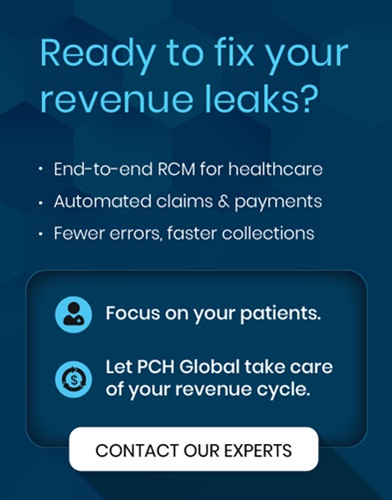
Understanding Revenue Cycle Analytics
RCA is defined as the use of data analysis to track and improve the financial performance in an organization. It has proven to play a crucial role in revenue cycle management (RCM) in healthcare. It has helped providers simplify billing and reduce denials.
RCA was primarily a manual process traditionally. It relied heavily on spreadsheets and basic financial reports. RCA has moved away from its traditional approach with the rise of AI.
Hospitals and clinics started implementing electronic health records (EHRs) in the early years of 2000s. This was done to digitize billing and claims management. Predictive analytics and automation took center-stage by the year 2010. Since then, AI-powered platforms can analyze large sets of data, predict trends, and proactively mitigate revenue leakage.
Types of Revenue Cycle Analytics
RCA can be grouped into four main categories.
Descriptive analytics focuses on summarizing historical data to present a view of past performance. Diagnostic analytics takes it one step further - it tries to understand the trends and reasons behind the said performance.
Predictive analytics on the other hand does not rely on historical data, and instead uses AI to predict future revenue trends and potential payment delays. Finally, prescriptive analytics gives suggestions on actionable steps to optimize revenue.
While these categories are relevant, emerging types of advanced AI can also be integrated into the RCA process. For example, Olive AI and Change Healthcare use deep learning to enhance predictive and prescriptive analytics. Traditional RCA, be it descriptive or diagnostic, is also rule-based, whereas predictive and prescriptive analytics can evolve with time and dynamically adapt to changing healthcare payment environments.
Key Revenue Cycle Analytics Processes
The revenue cycle includes multiple interdependent stages, where analytics often play an important role. It starts with patient registration and insurance verification. In this, analytics help detect missing data and suggest corrections in real time. RCA also helps ensure compliance and precision in coding practices, since both medical coding and charge capture are so critical for accurate medical billing.
Post claims submission, RCA helps with denial management. It does so by identifying patterns in rejected claims and providing recommendations for potential future issues. Automated dashboards can help track payments and flag discrepancies to ensure financial accuracy once the payment is posted.
Lastly, financial reporting allows healthcare organizations to use real-time insights to make informed decisions. Cross-departmental collaboration is essential. This is achieved by RCM teams, compliance officers, IT departments, and healthcare providers working together to ensure seamless data flow and accurate analysis.
Benefits of Revenue Cycle Analytics for RCM
A structured approach to RCM is required to successfully implement revenue cycle analytics. The process starts with a careful assessment of the financial bottlenecks. This is followed by a goal-setting phase, where key performance indicators are defined to measure success. Once the objectives are clear, the next step is to select the right AI-powered tools that complements the healthcare organization’s needs and existing structure.
Leadership involvement and staff’s skill training are critical for the successful adoption of RCA. First, the executive buy in is sought, followed by training the staff on how to interpret and utilize the analytics tool. Then effort is made to align the RCA tools with existing EHR and medical billing systems.
Ongoing maintenance and continuous improvement and compliance with regulations are essential components of any successful practice. Real-time analytics can be used to track any discrepancies, which will reduce denials and grow revenue over time.
Key Performance Indicators (KPIs) for Revenue Cycle Analytics
Tracking the right KPI is essential for RCA to work optimally.
Traditional KPIs include accounts receivable (AR) days, which essentially tells us the time taken to collect payments. Another important metrics are denial rate and collection rates, the former of which is the percentage of claims denied by insurers and the latter is the percentage of billed revenue successfully collected. Understanding these metrics would ensure that services rendered are being correctly billed.
While traditional KPIs focus on historical data, emerging KPIs focus on predictive insights that are a more future-focussed approach to revenue cycle management. For instance, payment behaviour forecasting predicts which claims might face delays. This would allow the organizations to take proactive steps.
AI-driven claim approval likelihood calculates the probability of a claim being accepted or denied. Knowing this helps assess the risk accurately and take steps to mitigate it. For similar purposes, the patient financial responsibility index assesses a patient’s ability to pay, helping healthcare providers optimize financial assistance programs. It can also help understand revenue cycle outsourcing needs.
Data visualization is important and modern analytics dashboards integrate these KPIs into interactive visual reports. This helps decision-makers act quickly based on real-time data.
Role of AI in Revenue Cycle Analytics
Artificial intelligence is changing the way revenue cycle analytics is done by automating repetitive tasks, predicting claim denials. The tools have the ability to analyze large amounts of data to identify billing errors and predict reimbursement trends. They can also help in flagging potential compliance risks.
Also, machine learning algorithms have proven to improve coding precision. This is done by analyzing historical claim data and suggesting accurate codes for medical procedures.
Additionally, AI-powered chatbots assist patients with billing inquiries and improving patient engagement. They also help reduce administrative workload. Similarly, fraud detection systems that are driven by AI also help identify suspicious billing activities.
Natural language processing (NLP) improves medical documentation by ensuring that billing codes align with provider notes.
Common Challenges in Implementing Revenue Cycle Analytics
Despite the several benefits of RCA, it comes with its own set of challenges. One of the primary technological barriers currently is the presence of legacy systems that might not support AI-driven analytics. Many healthcare organizations struggle with interoperability issues as different IT systems fail to communicate effectively. To overcome these challenges, investing in cloud-based, interoperable RCA solutions is crucial.
Apart from technological barriers, human barriers also play a role in implementation difficulties. Many staff members may resist the application of RCA since they might lack the skills needed to understand the insights. Conducting regular training sessions and involving the staff in the decision making process can help address these concerns.
Leadership skepticism about the potential ROI of implementing RCA might also be a hindrance. Presenting data-driven case studies that demonstrate the financial and operational benefits of RCA can help gain executive support and drive adoption.
Why choose PCH Health?
PCH Health offers a RCA solution that integrates AI-driven insights, real-time data monitoring, and seamless interoperability with existing healthcare IT systems. Our platform enhances claim accuracy, reduces denials, and optimizes cash flow, ensuring sustainable financial performance.
With robust compliance features, user-friendly dashboards, and dedicated customer support, PCH Health empowers healthcare organizations to take control of their revenue cycles with confidence. Request a demo today.
